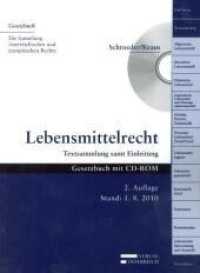- ホーム
- > 洋書
- > ドイツ書
- > Mathematics, Sciences & Technology
- > Medicine & Pharmacy
- > internal medicine and surgery
Full Description
Since its ?rst description in 1942 in both serum and cerebrospinal ?uid, transthyretin (TTR) has had an eventful history, including changes in name from "prealbumin" to "thyroxine-binding prealbumin" to "transthyretin" as knowledge increased about its functions. TTR is synthesised in a wide range of tissues in humans and other eutherian mammals: the liver, choroid plexus (blood- cerebrospinal ?uid barrier), retinal pigment epithelium of the eye, pancreas, intestine and meninges. However, its sites of synthesis are more restricted in other vertebrates. This implies that the number of tissues synthesising TTR during vertebrate evolution has increased, and raises questions about the selection pressures governing TTR synthesis. TTR is most widely known as a distributor of thyroid hormones. In addition, TTR binds retinol-binding protein, which binds retinol. In this way, TTR is also involved with retinoid distribution. More recently, TTR has been demonstrated to bind a wide variety of endocrine disruptors including drugs, pollutants, industrial compounds, heavy metals, and some naturally occurring plant ?avonoids. These not only interfere with thyroid hormone delivery in the body, but also transport such endocrine disruptors into the brain, where they have the potential to accumulate.
Contents
Mechanisms of Molecular Recognition: Structural Characteristics of Transthyretin Ligand Interactions.- Transthyretin Synthesis During Development and Evolution: What the Marsupials Revealed.- Evolution of Transthyretin Gene Structure.- Evolutionary Insights from Fish Transthyretin.- The Salmonella sp. TLP: A Periplasmic 5-Hydroxyisourate Hydrolase.- Vertebrate 5-Hydroxyisourate Hydrolase Identification, Function, Structure, and Evolutionary Relationship with Transthyretin.- Transthyretin-Related and Transthyretin-like Proteins.- The Transthyretin—Retinol-Binding Protein Complex.- Transthyretin and Retinol-Binding Protein: Implications in Fish Physiology.- Transthyretin and Endocrine Disruptors.- Genetics: Clinical Implications of Transthyretin Amyloidosis.- Molecular Pathogenesis Associated with Familial Amyloidotic Polyneuropathy.- Histidine 31: The Achilles' Heel of Human Transthyretin. Microheterogeneity is Not Enough to Understand the Molecular Causes of Amyloidogenicity.- New Therapeutic Approaches for Familial Amyloidotic Polyneuropathy (FAP).- Liver Transplantation for Transthyretin Amyloidosis.- Mouse Models of Transthyretin Amyloidosis.- What Have We Learned from Transthyretin-Null Mice: Novel Functions for Transthyretin?.- Transthyretin Null Mice: Developmental Phenotypes.- Transthyretin Null Mice as a Model to Study the Involvement of Transthyretin in Neurobiology: From Neuropeptide Processing to Nerve Regeneration.- Plasma Transthyretin Reflects the Fluctuations of Lean Body Mass in Health and Disease.- Erratum to.








